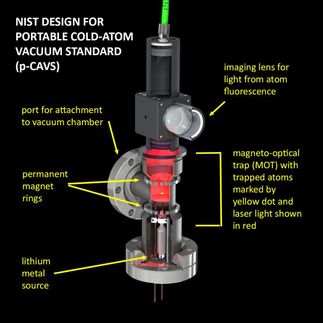Single atoms for detecting extremely weak forces
MPQ-scientists demonstrate that due to synchronisation atoms can be influenced by forces as weak as 5 yoctonewton
Back in the 17th century the Dutch physicist Christiaan Huygens made the observation that the oscillation of two pendulums synchronize once they get under mutual influence. This holds for even very loose coupling, for instance, when both pendulums are mounted onto the same wall. Interestingly, a large variety of oscillating systems shows this kind of behaviour, ranging from organ pipes to lasers or electronic circuits. A team of scientists in the Laser Sepctroscopy Division of Professor Theodor W. Hänsch at the Max Planck Institute of Quantum optics (MPQ) has now succeeded in observing this technically rather important phenomenon for a single extremely cold atom. As was shown in the experiment, the forces necessary for the synchronisation of the atomic oscillation with an external radiofrequency signal were as low as 5 yoctonewton (5 x 10e-24 N). Hence, single atoms can serve as extremely sensitive detectors for very weak forces – perhaps even sensitive enough for measuring the magnetic moment of a single molecule for the first time.
The experiment starts with storing a single magnesium ion in a so-called Paul-trap. The alternating fields of the trap keep the atom at a fixed point in space, whereas the very high vacuum guarantees that the ion oscillates without perturbation. The ion is then addressed by two well tuned laser beams which make it oscillate with an amplitude of around a tenth of a millimetre. High-resolution optics and a sensitive camera make it possible to register this oscillation by the emitted stray light. In order to investigate the synchronisation of the oscillation of the optically excited atom with an external source a second alternating field is applied to an electrode nearby, and the ion oscillation is monitored with a stroboscope. Once the frequency of the external signal is close enough to the oscillation frequency of the ion its motion sychronizes with the external field.
A careful determination of the forces exerted by the applied ac-field shows that even very small excitations of only 5 yN give rise to synchronisation. Without the experimental “tricks” described above it is almost impossible to detect forces of this order. For example, a force of 5 yN would displace the ion by only around one nanometer (10e-9 metre), whereas the amplitude of the ion oscillation due to its temperature already amounts to 5000 nanometres.
The extremely high sensitivity demonstrated in this experiment offers a variety of applications. For example, it could be used to measure the magnetic field of a single molecule for testing fundamental interactions. The experiment described here is a promising step in this direction. Maximilian Herrmann
Original publication: S. Knünz, M. Herrmann, V. Batteiger, G. Saathoff, T.W. Hänsch, K. Vahala, und Th. Udem; "Injection locking of a trapped-ion phonon laser"; Physical Review Letters 105, 013004 (2010)
Most read news

Get the analytics and lab tech industry in your inbox
By submitting this form you agree that LUMITOS AG will send you the newsletter(s) selected above by email. Your data will not be passed on to third parties. Your data will be stored and processed in accordance with our data protection regulations. LUMITOS may contact you by email for the purpose of advertising or market and opinion surveys. You can revoke your consent at any time without giving reasons to LUMITOS AG, Ernst-Augustin-Str. 2, 12489 Berlin, Germany or by e-mail at revoke@lumitos.com with effect for the future. In addition, each email contains a link to unsubscribe from the corresponding newsletter.
























































